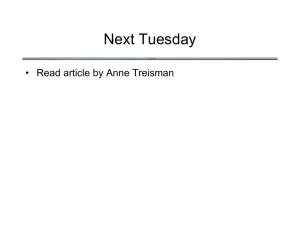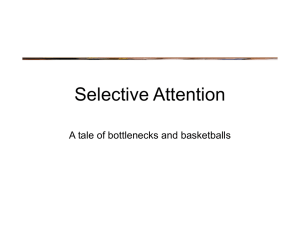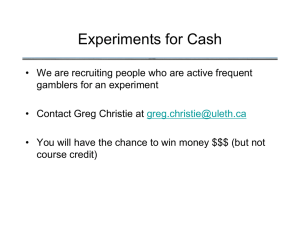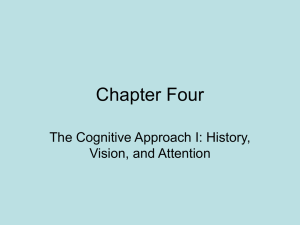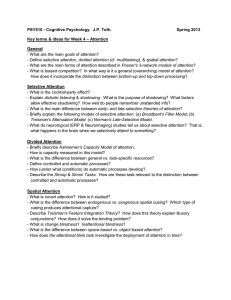Attention
advertisement
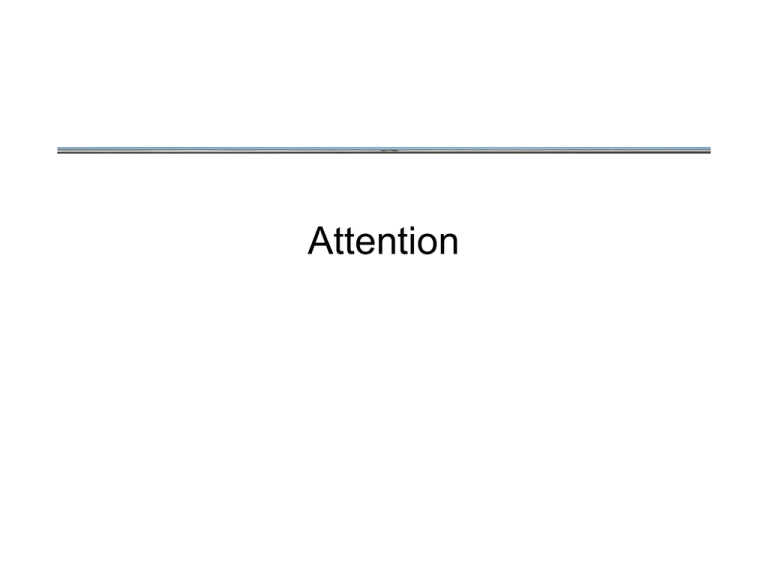
Attention What is “attention” • attention is poorly defined - different people mean different things by “attention” What is “attention” • attention is poorly defined - different people mean different things by “attention” – An aroused state: a state conducive to rapid perception and cognition. As in “pay attention!” What is “attention” • attention is poorly defined - different people mean different things by “attention” – An aroused state: a state conducive to rapid perception and cognition. As in “pay attention!” – Vigilance: maintaining a state of arousal- “paying attention in class” What is “attention” • attention is poorly defined - different people mean different things by “attention” – An aroused state: a state conducive to rapid perception and cognition. As in “pay attention!” – Vigilance: maintaining a state of arousal - “paying attention in class” – Selective Attention: focusing on one object or location to optimally deal with the sensory information coming from it What is “attention” • “Everyone knows what attention is. It is the taking possession by the mind in clear and vivid form, of one out of what seem several simultaneously possible objects or trains of thought...It implies withdrawal from some things in order to deal effectively with others…” - William James What is “attention” • James’ definition emphasizes two aspects of attention: important What is “attention” • James’ definition emphasizes two aspects of attention: important 1. That attention implies a suppression of information at unattended locations What is “attention” • James’ definition emphasizes two aspects of attention: important 1. That attention implies a suppression of information at unattended locations 2. That attention is a selection of some information for enhanced perception or mental operations Learning About Attention by Pushing the Limits • Ulrich Neisser – Tracking one moving object out of many Video of Basketball Game Learning About Attention by Pushing the Limits • Ulrich Neisser – Tracking one moving object out of many – About 50% miss the gorilla Learning About Attention by Pushing the Limits • Ulrich Neisser – Tracking one moving object out of many – About 50% miss the gorilla – Demonstration that unattended information is dramatically absent from consciousness Selective Attention A tale of bottlenecks and basketballs Two Distinct Processes • There are two processes which get bundled into our idea of attention: – orienting - shifting attention (usually in space, but also to non-spatial features such as pitch) – selection - what attention does to perception • These are often confused and used interchangeably • We’ll switch back and forth between the two, but we’ll try to keep them separate • First: the consequences of selection Information Theory: • ~1950’s: Psychologists began to think of the human perceptual mechanisms as “information processors” Information Theory: • ~1950’s: Psychologists began to think of the human perceptual mechanisms as “information processors” • Began asking questions such as “how much information can the human mind handle at once?” Information Theory • Donald Broadbent - earliest systematic investigations of selective attention Information Theory • Donald Broadbent - earliest systematic investigations of selective attention x x x o o o x o o Information Theory • Donald Broadbent - earliest systematic investigations of selective attention Information Theory • Donald Broadbent - earliest systematic investigations of selective attention – when simultaneous questions were asked, subject performed poorly on all questions Information Theory • Donald Broadbent - earliest systematic investigations of selective attention •First principle of human information processing: capacity is limited Information Theory • Donald Broadbent - earliest systematic investigations of selective attention Information Theory • Donald Broadbent - earliest systematic investigations of selective attention – when simultaneous questions were asked from physically separate speakers, and subject instructed in advance which question to answer, performance was nearly perfect Information Theory • Donald Broadbent - earliest systematic investigations of selective attention Second principle of human information processing: information sources can be selected Shadowing • Many early studies employed variations on a paradigm called “shadowing” “Four score and seven years ago…” “Four score and seven years ago…” “It was the best of times, it was the worst of times…” Shadowing • Many early studies employed variations on a paradigm called “shadowing” – subjects could easily recall details of the shadowed passage but not of the ignored passage Shadowing • Many early studies employed variations on a paradigm called “shadowing” – subjects could easily recall details of the shadowed passage but not of the ignored passage – led to the idea that the perceptual mechanisms involve one or more “filters” to shut out unwanted information Stages of Selection • Broadbent: Early Selection - a bottleneck exists early in the course of sensory processing that filters out all but the attended channel • Alternative theory: Late Selection - the bottleneck exists not at the lowest stages, but at the highest - such as response planning, memory and consciousness Stages of Selection Stages of Selection • Testing Early Selection Theory - what prediction can be made? Stages of Selection • Testing Early Selection Theory - what prediction can be made? • Information (such as words) in unattended channel shouldn’t be processed for meaning Stages of Selection • Testing Early Selection Theory - what prediction can be made? • Information (such as words) in unattended channel shouldn’t be processed for meaning • Demonstrates that Early Selection Theory is not entirely correct Stages of Selection • Testing Early Selection Theory - what is another prediction that can be made? Stages of Selection • Testing Early Selection Theory - what is another prediction that can be made? • Should be able to find differences in brain activity in primary sensory areas (A1, V1) Stages of Selection • Electrical activity recorded at scalp (EEG) shows differences between attended and unattended stimuli in A1 within 90 ms Hansen & Hillyard (1980) Stages of Selection • Evidence exists for both early and late selection mechanisms – One interpretation: early reduction in “sensory gain” followed by late suppression of unselected information Next Time • Read article by Anne Treisman
